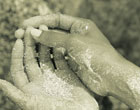| What is Ku Nye?
Ku Nye originated from the ancient kingdoms of Tibet over 3900 years ago and is a practice indigenous to the Tibetan Medical tradition. Earliest Tibetans practiced Ku Nye through the diagnosis and application of specific infused oil or substances extracted from butter to treat the person’s imbalance or constitution. Tree branches, sticks and stones were widely used as part of therapy to exert pressure on different parts and points of the body in order to restore the individual to a state of health and wellbeing. Literally, Ku means ‘to apply’ or to anoint the body with therapeutic oils to be absorbed through the skin and Nye refers to the actual massage. Techniques of Nye include the kneading, rubbing and pressing of muscles and tendons and the application of pressure to various points and channels. Chi is the final part of Ku Nye therapy which involves cleaning the oils from the body using barley or chickpea powder. Other ingredients may be added to the base powders depending on the person’s diagnosed condition. Another common name for Ku Nye is Chukpa (Tib. Byugpa)
The Traditional Tibetan Medicine system is a detailed and integrated one with 2 main objectives; prevention aspect of illness and the curative aspects of illness where treatments generally fall into four basic categories
- Therapeutic Diet
- Modifications to Lifestyle
- Use of Herbal Medicines
- Application of External Therapies
Ku Nye belongs to the fourth category of treatment and is part of a wealth of external therapies available in Traditional Tibetan Medicine used to maintain or restore balance to the organism. Other external therapies include; various types of moxabustion, stick therapy, cupping, Lums bathing therapy, stone and shell massage, and the use of compresses. The rejuvenating and restorative benefits and functions of Ku Nye are mentioned in many original Tibetan texts including the Bum Shi, Gyud Shi and all its commentaries and Ton Huang medical text. Some of the benefits include the elimination of toxins which store in the body and increased vitality, the reduction and alleviation of various types of pain and pain syndromes, the calming of nervous disorders including insomnia, depression and anxiety.
|


